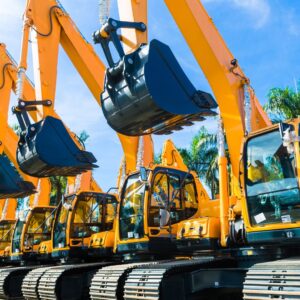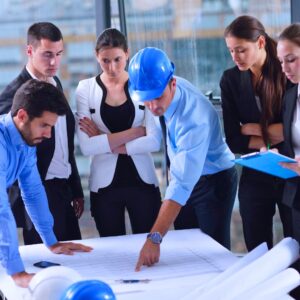Digitalization is transforming the construction industry, bringing efficiency, precision, and new capabilities that improve all aspects of projects, from planning to execution and maintenance. The adoption of digital technologies has allowed construction companies to optimize processes, reduce costs, and deliver better results in terms of both quality and sustainability. Below, we explore how digitalization is changing construction:
- BIM (Building Information Modeling): Construction Information Modeling
One of the most revolutionary technologies in construction is BIM. This digital tool allows architects, engineers, and contractors to work on an interactive 3D model that integrates detailed information about all aspects of a project, from the structure to electrical and plumbing systems. The benefits include:
- Real-time collaboration: Everyone involved in the project can access and update the model simultaneously, improving communication and reducing errors.
- Visualization and simulation: It allows simulating different scenarios and foreseeing problems before they arise on-site.
- Optimization of costs and timelines: By identifying potential conflicts or inefficiencies during the design phase, BIM helps avoid costly delays and changes on the construction site.
- 3D Printing in Construction
3D printing is emerging as a key technology in the construction industry, especially in the design of complex structures and custom components. Some of its applications are:
- House construction: 3D printers are being used to build affordable and low-cost houses, which could revolutionize the construction of affordable housing.
- Prefabricated elements: 3D printing facilitates the creation of custom architectural components with greater precision and speed than traditional methods.
- Waste reduction: By printing components on demand, material waste is minimized, and resource use is optimized.
- Drones for Inspection and Monitoring
The use of drones in construction has become popular due to their ability to perform inspection and monitoring tasks efficiently, saving time and resources. Their main applications are:
- Worksite inspection: Drones can easily access hard-to-reach areas to capture images and videos, providing detailed data on the progress of the work.
- Topography and terrain surveying: Drones are used to create topographical maps and digital terrain models with high precision.
- Safety monitoring: Drones can monitor safety on the construction site, detecting potential risks and improving preventive measures.
- Augmented Reality (AR) and Virtual Reality (VR)
Augmented reality (AR) and virtual reality (VR) technologies are changing the way construction projects are visualized and designed. These technologies allow work teams to:
- Interactive simulations: Architects and clients can experience a virtual 3D model of the project before actual construction, making it easier to make design decisions.
- Safe training: Using VR, workers can train in a simulated environment, improving their safety and skills without physical risk.
- Better communication with clients: Clients can interact with the completed project, allowing them to better understand the space and make adjustments before construction.
- Internet of Things (IoT) in Construction
The Internet of Things (IoT) is introducing connected devices that collect and analyze real-time data to improve performance and safety in construction projects. Some applications are:
- Sensors in construction equipment: Sensors monitor the condition of equipment, alerting about failures before they occur, reducing downtime and improving productivity.
- Monitoring working conditions: Sensors on-site can measure factors like temperature, humidity, and air quality, ensuring a safe work environment.
- Inventory management: Sensors can also track the consumption of materials and tools, facilitating efficient resource management.
- Automation and Robotics
Automation and robotics are revolutionizing several aspects of construction, improving accuracy and reducing risks for workers:
- Construction robots: Robots like the d-bot, which can lay bricks, or welding robots, are streamlining certain construction tasks, making them faster and more precise.
- Exoskeletons: Construction workers can use exoskeletons to improve strength and endurance, reducing fatigue and injury risks.
- Autonomous machinery: Autonomous excavators and trucks can operate without human intervention, improving efficiency and reducing errors.
- Big Data and Predictive Analytics
The collection and analysis of large amounts of data through Big Data and artificial intelligence (AI) are helping construction companies make more informed decisions:
- Prediction of deadlines and costs: Analyzing data from past projects allows for forecasting construction timelines and costs, helping avoid overruns and delays.
- Logistics optimization: Data analysis helps optimize the flow of materials and resources on-site, reducing wait times and improving overall efficiency.
- Predictive maintenance: Using AI, companies can predict equipment wear and schedule preventive maintenance, reducing the risk of breakdowns and extending asset life.
- Cloud-based Project Management Platforms
Cloud-based project management platforms allow construction teams to collaborate in real-time from anywhere. These platforms facilitate:
- Efficient communication: Teams can quickly exchange information, ensuring everyone is up to date on progress and issues.
- Progress tracking: Project managers can monitor the construction progress, managing resources and deadlines effectively.
- Centralized documentation: All plans, contracts, and project details are stored centrally, making information easier to access and reducing the risk of errors.
- Sustainability through Technology
Digitalization also plays a key role in improving sustainability in construction. Technologies allow for:
- Energy efficiency analysis: Digital simulations allow for studying the energy performance of a building before it is constructed and making adjustments to improve efficiency.
- Use of eco-friendly materials: Digital platforms help construction companies find sustainable materials and calculate their environmental impact.
- Waste management: Optimization technologies help reduce the amount of waste generated on-site and manage it properly.
Conclusion
Digitalization in construction is profoundly transforming the sector, making projects faster, more efficient, cost-effective, and sustainable. Technologies like BIM, 3D printing, drones, augmented reality, and IoT are changing the way construction companies plan, execute, and maintain projects. As these technologies continue to evolve, construction is expected to become smarter, more efficient, and better equipped to address future challenges such as sustainability and global urbanization.




